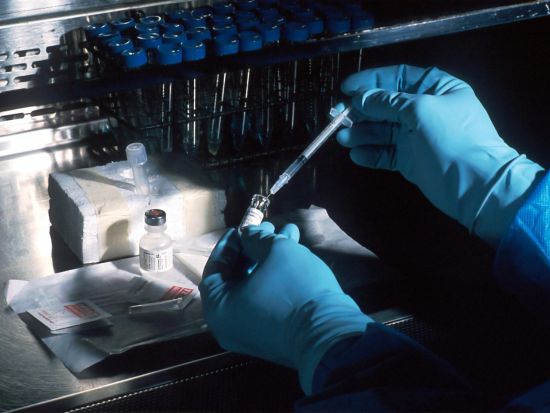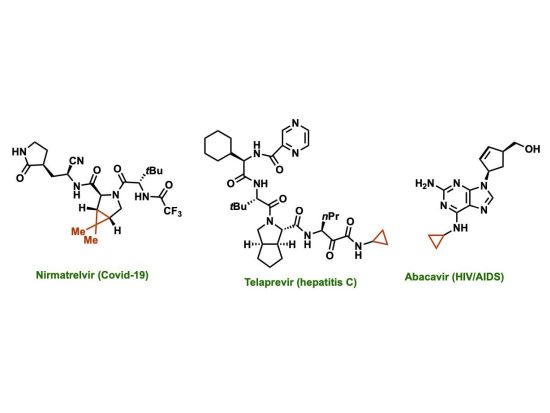New, simple and accessible method creates potency-increasing structure in drugs
Previously undescribed chemical process may offer safer, more practical way to create cyclopropanes — a key feature in many drugs and drug-candidates.

A new method offers a simple, safe, and practical way to create cyclopropanes—a key feature that increases the potency of many drugs and drug-candidates—within molecules.
Credit: National Cancer Institute/Unsplash. All Rights Reserved.
AUGUST 3, 2023 By Gail McCormick
UNIVERSITY PARK, Pa. — Chemical structures called cyclopropanes can increase the potency and fine-tune the properties of many drugs, but traditional methods to create this structure only work with certain molecules and require highly reactive — potentially explosive — ingredients. Now, a team of researchers from Penn State has identified and demonstrated a safe, efficient and practical way to create cyclopropanes on a wide variety of molecules using a previously undescribed chemical process. With additional development, the new method — described in a paper publishing tomorrow (Aug. 4) in the journal Science — could transform how this important process occurs during drug development and creation.
Cyclopropanes are a key feature in many drugs currently approved by the U.S. Food and Drug Administration, including those used to treat COVID-19, asthma, hepatitis C and HIV/AIDs. These structures can increase a drug’s potency, alter its ability to dissolve in the body, minimize its interactions with unintended targets, and otherwise fine-tune performance. Cyclopropanes are a ring of three connected carbon atoms, with one carbon attached to the rest of the drug molecule and the other two each attached to two hydrogen atoms.
“Cyclopropanes are an essential component of many drugs and adding them to drug candidates can be an important part of the drug discovery process,” said Ramesh Giri, professor of chemistry in the Eberly College of Science at Penn State and leader of the research team. “Previous efforts to improve the creation of cyclopropanes have focused on altering a mechanistic pathway devolved more than 60 years ago. We approached this from a different angle and identified a completely new pathway that is a simple, practical, and broadly applicable.”
The new method transforms a specific chemical structure on compounds called alkenes — used in the synthesis of many molecules — into cyclopropanes. The method takes advantage of “radical chemistry,” where intermediate steps of reactions leave some carbon atoms with unpaired electrons called “free radicals” that propel the reaction forward. This specific method uses visible light to initiate the reaction and uses common chemical ingredients, including oxygen.

Cyclopropanes are ring of three connected carbon atoms that occur in many drugs currently approved by the FDA, including those used to treat COVID-19, asthma, hepatitis C, and HIV/AIDs. On a chemical diagram, they appear as a triangle (noted here in red), with a carbon atom at each point of the triangle. One of the carbon atoms is attached to the rest of the drug molecule and the other two are each attached to two hydrogen atoms. Credit: Giri Lab / Penn State. Creative Commons
Traditional methods to create cyclopropanes require highly reactive and difficult-to-acquire ingredients and must be conducted under controlled conditions, and the resulting compounds often have a very short shelf life. These unstable ingredients are critical to producing an intermediate compound in the process called a carbene — a highly reactive carbon atom with two unpaired electrons. The new method completely bypasses the carbene intermediate, producing the unpaired electrons one at a time as radicals.
“All of the ingredients used in this pathway are commercially available or easy to create in the lab and do not require any special safety precautions, and the end product can be stored for prolonged periods,” Giri said. “We can add all the ingredients together in one mixture while exposed to air with as little as 10% oxygen, and it proceeds in one step. The reaction is simple and safe enough that we are even planning to include it as part of an undergraduate chemistry lab.”
Another shortcoming of traditional methods is that they generally do not work with complex molecules. For this reason, cyclopropanes are typically installed early in the synthesis when the molecule is less complex, but following steps can cause the ring to open up, and later attempts to make derivatives of the molecule would require backtracking to those early steps. Using the new method, the researchers successfully transformed a variety of alkenes with a wide range of complexities into cyclopropanes, including pharmaceutically relevant compounds such as the steroid estrone, penicillin and vitamin B.
“We explored the entire range of molecule complexity that people might encounter during drug synthesis,” Giri said. “In some cases, traditional methods might be able to develop the same end product but in many more steps. In other cases, traditional methods would be unable to create these products, because the starting alkenes are too sensitive or too complex. The new method is not only safer, more efficient and more practical, but has a wider range of applications than traditional methods.”
Some of the ingredients in the reaction can also be swapped out to add additional chemical groups to the final product to achieve various therapeutic goals. One of the reaction’s ingredients is as a type of compound called a methylene. There are hundreds of different methylenes that are commercially available, each with a specific chemical group that makes it a methylene as well as other groups that differ and could theoretically be added to the alkene as a cyclopropane is created. The researchers demonstrated the breadth of the new method using 19 different methylene compounds.
“The idea of using a visible light-based reaction and radical chemistry to transform alkenes into cyclopropanes using methylenes at first seems counterintuitive, which is why it was so important for us to thoroughly demonstrate this new catalytic method,” Giri said. “The key insight was introducing oxygen into the reaction, which helps create a radical that then interacts with the alkene. My lab has been studying other reactions that use alkenes to create a radical and wondered if the same idea could be applied to creating cyclopropanes.”
Next, Giri and his lab plan to scale up the method so that it is industrially viable.
“With future development and scaling up, this method has the potential to transform the way alkenes are cyclopropanated, which could have important implications for drug discovery, development and creation,” he said.
In addition to Giri, the research team at Penn State includes postdoctoral researcher Dhruba Poudel, postdoctoral researcher at the time of the research Amrit Pokhrel, postdoctoral researcher at the time of the research Raj Kumar Tak, and postdoctoral research Majji Shankar. The U.S. National Institute of General Medical Sciences and Penn State supported this research. A patent application has been filed for this novel method. For technology transfer or technology licensing inquiries, please contact Suzanne Kijewski.
Contact:
Gail McCormick,
gailmccormick@psu.edu
Source: https://www.psu.edu/news/eberly-college-science/story/new-simple-and-accessible-method-creates-potency-increasing-structure/
"Reproduced with permission - The Pennsylvania State University | Penn State"
The Pennsylvania State University | Penn State
For more HIV and AIDS News visit...
Positively Positive - Living with HIV/AIDS:
HIV/AIDS News |